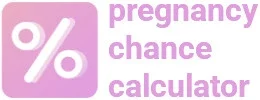Phase:
Welcome to the Pregnancy Chance Calendar, your go-to resource for tracking your menstrual cycle, predicting fertile windows, and estimating personalized daily pregnancy probabilities. Whether you’re actively trying to conceive or simply exploring your fertility patterns, this calculator delivers precise predictions based on your specific period-start date, cycle length, age, and personal lifestyle factors.
How to Use the Pregnancy Chance Calendar
Enter Your Cycle Details:
- Select your typical menstrual cycle length (e.g., 28 days) and input the start date of your most recent period.
- For advanced personalized estimates, enter additional details such as age, height, weight, average weekly work hours, daily cigarette usage, and weekly alcohol consumption. These inputs help accurately calculate your ovulation date, fertile window, and personalized daily pregnancy chances.
- Press Calculate to generate your personalized calendar.
Interpret the Calendar:
- Dark Red Cell: Indicates the first day of your period.
- Light Red Cells: Show estimated menstruation days.
- Light Blue Cells: Highlight your fertile window—days when pregnancy is most likely.
- Dark Blue Cell: Marks your highest-chance day for pregnancy.
- Green Cell: Indicates your estimated ovulation day.
- Cells outside these periods show minimal pregnancy chances (<0.1%).
Pregnancy Chances:
- Each calendar date displays a percentage (e.g., “12%”) at the bottom.
- This percentage represents the estimated likelihood of pregnancy if intercourse occurs on that day, calculated from your personalized inputs (including contraceptives entered) and scientifically validated fertility data.
How It Works
Our calculator is built on decades of scientific research into the menstrual cycle. Typically, ovulation happens about 14 days before your next period starts. By using this simple principle along with your cycle length, and data from several peer-reviewed, large-scale studies (primarily Faust et al 2019 and Wilcox et al 1995), our tool calculates several key dates in your cycle:
- Fertile Window: The days when your body is most receptive to conception.
- Approximate Ovulation: The day when your egg is most likely released.
- Highest Chance Day: Usually the day before ovulation, when your chances of conceiving are highest.
- Next Period & Pregnancy Test Day: These dates help you understand what to expect next, as well as when a pregnancy test might first be accurate.
- Estimated Pregnancy Chance Per Day
The calendar below your results updates dynamically as you enter or adjust your information. It lets you visualize each day in your cycle—even if you navigate forward or backward in the month.
The Science Behind Our Pregnancy Chance Calendar
Your menstrual cycle is a complex process influenced by numerous factors, from your age and lifestyle to underlying health conditions. Our calculator harnesses well-established clinical methods and peer-reviewed research to estimate your fertility window and key dates accurately. Think of it like a weather forecast: while the exact timing can vary slightly from cycle to cycle, the overall model gives you a reliable guide to your body’s rhythms.
We know that even small differences—like when exactly ovulation occurs—can have a big effect on your chance of conceiving. That’s why our tool considers not just the general timing but also adjusts percentages (your “pregnancy chance” for each day) to reflect the variations throughout your cycle. This way, you’re not just seeing dates—you’re getting an insight into how the odds shift day by day.
Health Disclaimer
This calculator provides only an approximation of your menstrual phases and fertility window based on average biological patterns. It relies on the accuracy of the period-start date and cycle length you enter—note that no one knows the length of their current menstrual cycle until the cycle has completed. All results are estimates and may change. This tool is intended for informational purposes only and is not medical advice. Always consult a healthcare professional for personalized guidance on fertility, pregnancy, and reproductive health.
